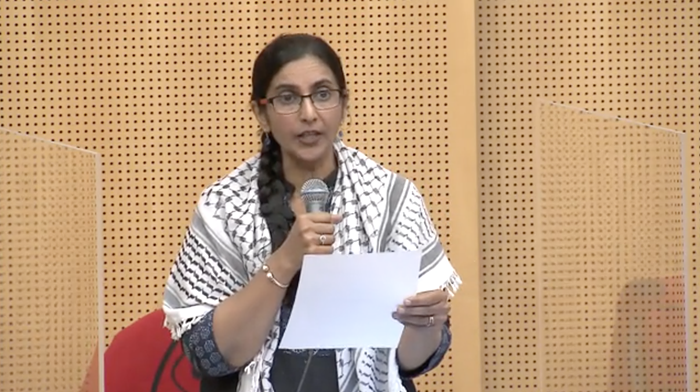
4/13: This post has been updated with new information.
A group of about 50 activists gathered outside the Northwest Detention Center in Tacoma on Tuesday night. From the sidewalk outside the prison’s gates, the demonstrators—wives, children, partners, and strangers—rallied in support of those inside.
About 415 detainees at NWDC, mostly undocumented immigrants picked up by Immigration Customs and Enforcement (ICE), had stopped eating to protest conditions at the facility, according to community organizers in touch with people participating in the hunger strike. It was day two without food.
The strike, which began on April 10, also came with a list of demands, including more nutritional food served in the cafeteria, reasonable commissary prices, speedier court proceedings, prompter medical care, and higher pay for prison labor. Demonstrators planned to camp outside the prison overnight.
“Nobody goes on a hunger strike because it’s fun, because they have nothing to do, or to call attention to themselves,” said Maru Mora Villalpando, an organizer for NWDC Resistance, told me during the rally.
The strike couldn't be more timely. It comes as the Trump administration moves to loosen regulations on immigration detention centers, including regulations on medical care, suicide prevention and solitary confinement.
Villalpando said she wasn’t sure how long the hunger strike would last, but she was getting word via e-mails and phone calls from within the prison that more people were joining the effort.
“It seems this is going to last [longer]," Villalpando said. "We know people tried to talk with ICE and negotiate with them. They wanted to come to an agreement and get a signed agreement.”
ICE requires detainees to go without any food for 72 hours before declaring an official hunger strike. As of Wednesday evening, officials with ICE said none of the participants had met that threshold.
“I’m told that timeframe will be tomorrow after breakfast," Virginia C. Kice, spokesperson for ICE’s Western region, wrote in an e-mail.
NWDC detainees last held a hunger strike in 2014, which made national headlines. The detainees’ demands bore striking resemblance to the demands being made this week: raising the $1 daily wage for prison labor and better food.
In an interview on Monday, Ricky, a Guyanese national who has been incarcerated at NWDC for more than three months, told The Stranger that the poor quality of food has affected detainees’ bowel movements. Ricky also described detainees' daily complaints about medical care, skyrocketing prices for commissary items, and how their sleep is impacted by lighting within the prison.

Britny Rau said her longtime partner, Jorge Antonio Francisco, 36, had lost about seven pounds since he was brought to NWDC on April 5 because the food was making him feel sick. Her partner is participating in the hunger strike, she said.
Francisco, who has been in the United States for about 23 years, was detained about three weeks after he was fined for a “minor traffic violation,” Rau said. He now faces deportation to Mexico, where he no longer has any family. Francisco’s 15-year-old son, Augustino Lucas, said he missed seeing his dad every day when he came home from work.
“You can’t hold yourself,” Augustino said.
Since his father was detained, “everything changed” and he became “stressed and sad.” Worrying about his father at NWDC and whether he will be deported has made school more difficult, too, but Augustino has received support from his track and field coach.
Rau said Francisco calls Augustino and his siblings, Alex, 12, and Reina, 11, every night to say good night.
Like so many other immigrants, Rau said, Francisco came here for a better life.
Grace Chavez also attended the rally. In early February, she said her husband, Armando, was detained by ICE after he was rear-ended while driving on the highway after leaving his job as a cook at a Tacoma IHOP. Armando was immediately taken to NWDC and was never offered medical assistance from injuries sustained during the car accident, Grace claimed. Within the next two days, ICE officials informed Grace that her husband was being processed for deportation. He was sent to Mexico City at the beginning of March.
Today, Grace said Armando isn’t often able to talk with her or their kids, Emmanuel, 19; Elizabeth, 18; or Ashlee, 12; because of her work and the kids’ school schedules. Armando is barely able to walk due to his injuries, she said.
“My dad was hard working,” said Ashlee. “He would always make me laugh and smile.”
“If anybody is asking themselves if we need this place [NWDC],” said Villalpando, “whether we should be deport people or detain people this way, they should take a look at themselves and their humanity. Because maybe they lost it.”

Outside the detention center’s gates, activists led chants such as “No estan solos! You are not alone!” or “Sí se puede! Yes we can!” In the quiet of the night, some heard people detained inside shouting back. Hopeful smiles were exchanged between family members and demonstrators.
Inside the facility, detainees watched local television reports of the rally happening outside the building. Some of them could hear activists chanting.
“Everybody had a cheery attitude after that,” said David Modesto Gonzalez, a Mexican immigrant who came to the United States as a child, in a phone interview with The Stranger Wednesday morning. Gonzalez is among the detainees participating in the hunger strike.
“I’m going to be honest with you, I feel light headed, funky," he said. "Every little thing of food, it comes in the trays. I think, ‘Oh man. I just really want to grab that.’ But I know I have to stick to my guns and follow through with the protest. I’d be lying if I said I wasn’t hungry.”
UPDATE, 4/13 at 9:30 a.m.: As of Thursday morning—day four of the hunger strike—more than 750 detainees were participating in the strike, Villalpando wrote in a media statement.
ICE representatives said the department still isn't considering the protest an official hunger strike.
"We are still assessing the situation," Kice wrote in an e-mail. "While some detainees have now declined meals for 72 hours, many were continuing to consume commissary items. We hope to have a more detailed update later today."
Steven Hsieh contributed reporting to this story.


















